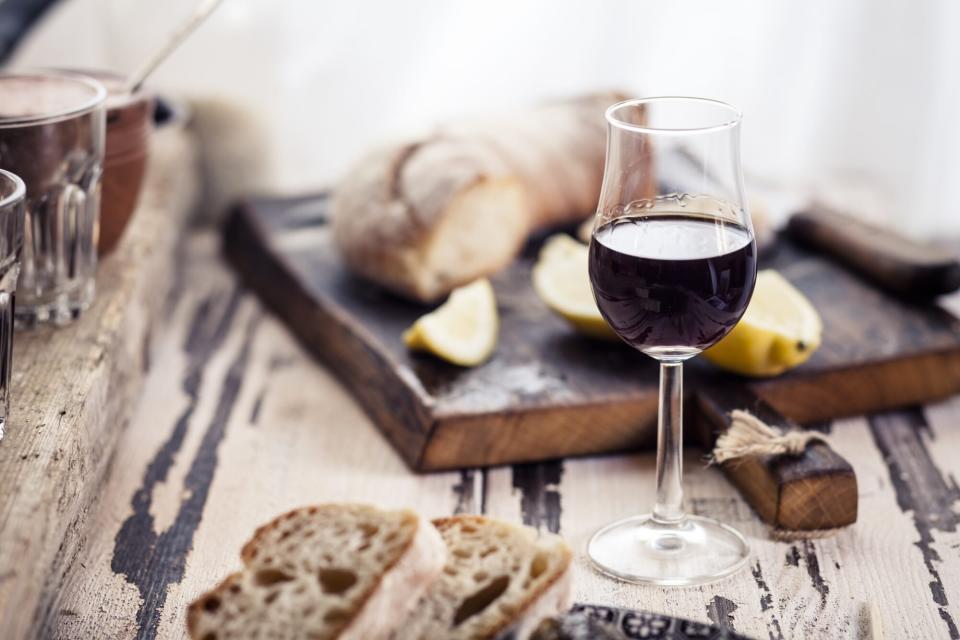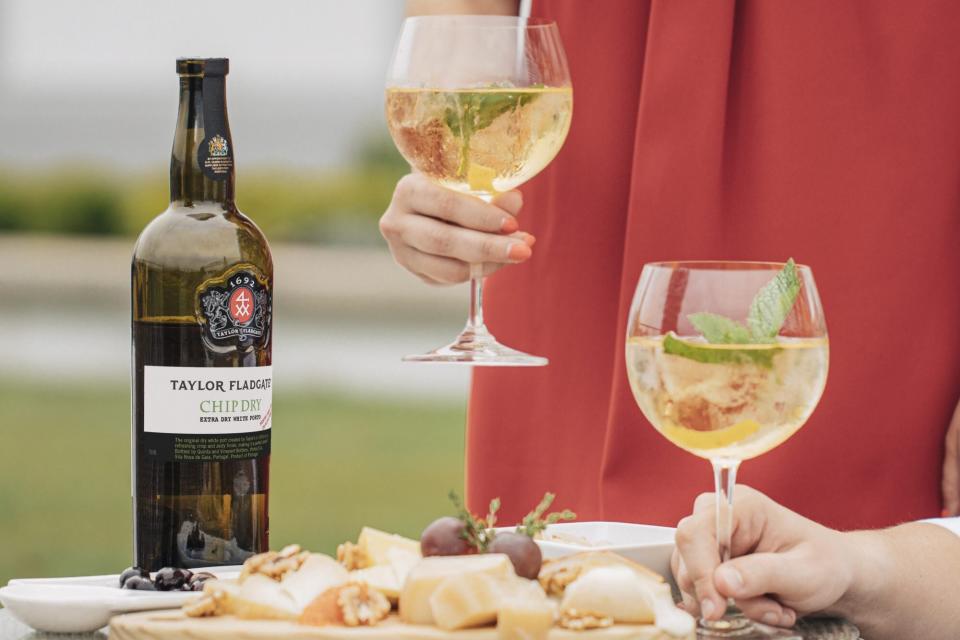All About Port Wine, the Sweet Sip Everyone Should Try

Craving a rich, smooth, sweet wine to sip leisurely while you enjoy some dark chocolate or cheese? Looking for a new aperitif? Consider port. It's a versatile, sweet wine from Portugal that's fortified—meaning, a little neutral distilled grape spirit (essentially, brandy) has been added to the wine during fermentation. This fortification process has two main effects on the finished wine: Port is a bit stronger than table wine (containing 18-22 percent alcohol by volume, where most table wines top out around 15 percent), and it's also sweeter. That's due to the fact that the brandy is added to the wine right in the middle of the fermentation process when there is still a good amount of natural sugar present that hasn't yet been consumed by the fermenting yeast. The alcohol in the brandy kills the yeast cells, preserving the natural sugars. No sugar is added to port; what you're tasting is the pure natural sugar present in the ripe grapes that make port.
Related: How to Decode a Wine Label

Getty / Westend61
What Makes Port Special?
While port isn't the only fortified wine in the world (sherry, Madeira, Marsala, and vermouth are also fortified wines), Natasha Bridge, former chief blender for Taylor Fladgate, explains what makes port so special: "Fortification stops the fermentation, leaving some natural sweetness of the grape, making it rich, round, and smooth on the palate. The different styles of port derive essentially from the various ways in which it can be aged. Port will continue to improve in cask, vat, or bottle for much longer than most other wines. The choice of aging period and aging vessel will determine the style of the port."
Port's Fascinating History
Port has an interesting story that's a treat to bring to a dinner party. Although port is a product of Portugal, it's really thanks to the British that the wine was created and popularized. Because Britain hasn't traditionally had the ideal climate for grape-growing, the Brits were historically dependent on France for most wine imports. However, in the 17th and 18th centuries, Britain was at war with France and boycotted French wines. That meant they had to look elsewhere for imports. It was discovered that Portugal's Douro Valley was an incredible growing region for quality grapes that made rich, concentrated wines. However, these wines didn't travel well—they had to be first floated in barrels down the Douro River, from the region where they were originally vinified, to the town of Oporto, where they were aged. They were then were shipped to England and often arrived spoiled. The solution? Adding a little brandy to the barrels the wines were shipped acted as a fabulous preservative.
Even though we now have other innovative options for stabilizing wine, the tradition of fortifying port lives on. Instead of adding the brandy after the wine is made to preserve it, it's now added during the winemaking process. History and tradition are still huge parts of port; in fact, many port houses still tread their grapes by foot in huge tanks called lagares. And for the most part, the port brands you will find on store shelves are still the ones founded by British families. Cockburn, Croft, Dow, Graham, Osborne, Sandeman, and Warre are all popular and easy to find.

Courtesy of Taylor Fladgate
Breaking Down Port Styles
There are numerous styles of port, all made from native Portuguese grapes. The first is ruby port, a rich and smooth sip with luscious dark berry and chocolate flavors. Since there are plenty of affordable ruby ports available, this style can be a good place to start your exploration into this type of wine. Try pairing it with Dark Chocolate Truffles Next up is tawny port: Tawny ports are aged in small oak barrels for a longer period of time than ruby, so they are exposed gradually to oxygen which creates a golden brown color and nutty flavor. Tawny port often taste like toffee, caramel, hazelnuts, graham crackers, and butterscotch. For the best taste, try pairing twany port with a cheese board or Honey-Roasted Salted Figs. Bridge recommends tawny as a great accompaniment to Tarte Tatin.
Created by Croft in 2008, rosé port is an exciting new category—and it's easy to see why. After all, if rosé is taking the wine world by storm, why not also port wine? The wine is made by leaving the skins on the grapes for a short time to get the desired bright pink color, then aged in steel tanks briefly and bottled young and fresh. It has bright strawberry and cherry flavors; it's great chilled or served on ice with a squeeze of lime. Bright and slightly sweet, it goes well with spicy dishes. Try pairing rosé port with Spicy Shrimp Fajitas with Grilled Pineapple Pico
Made with Portuguese white grapes including malvasia, rabigato, viosinho, and gouveio, white port has flavors of citrus, apricots, baked apple, and almonds. Try it in cocktails; Bridge recommends this simple one made with Taylor's Chip Dry and tonic: "Pour in a high ball glass, with two or three cubes of ice, topped up with tonic water, a sprig of mint and slice of lemon. It's the perfect aperitif with some salted almonds or rich pâté." Enjoy a glass of white port with Olive-Oil Roasted Almonds or Fried Olives.
By far the most expensive and coveted port is vintage, because it is made only from grapes grown in a particularly excellent year. (Other ports are blends of many different vintages.) Not every year is declared worthy of a vintage port, as vintage years are rare and it's generally thought that a vintage port needs to age anywhere from 10 to 40 years in the bottle before it is ready for drinking. However, this makes it a great gift for a collector. You can't go wrong pairing a vintage port with Stilton Cheese. Last but not least is the category called late bottle vintage (LBV). These are ports that may have been intended for vintage port, but instead were left to age in the barrel for four to six years; for that reason, they're ready to drink right after bottling. If you want to taste a little of that vintage experience without waiting 40 years, LBV is the style for you. Enjoy an LBV port with the same types of foods you'd pair with vintage port. Our Blue Cheese Gougères with Caramel and Salt would be a good start.
How to Serve Port
Port should be served slightly cool, around 60 degrees. Because port is fortified, it stays fresh when opened longer than table wine. For ruby style, drink an open bottle within two weeks; tawny should be able to go about a month. The same storage rules apply as preserving a table wine: pump the oxygen out of the bottle, and keep the open bottles in your fridge. Because it's so rich and strong, the serving size for port is smaller than table wine: three ounces is standard (versus five to six ounces for table wines.) Specialty port glasses are smaller and often tulip-shaped to show off the aromas.

